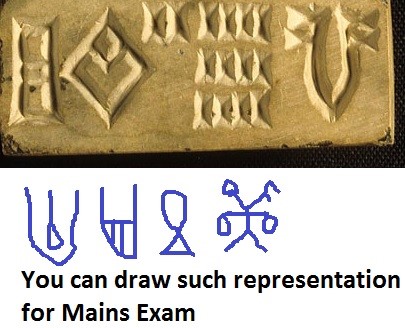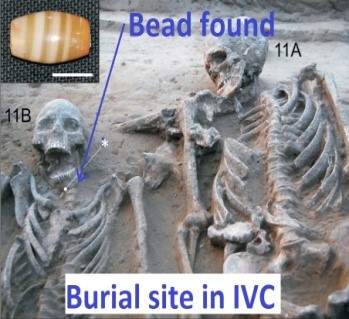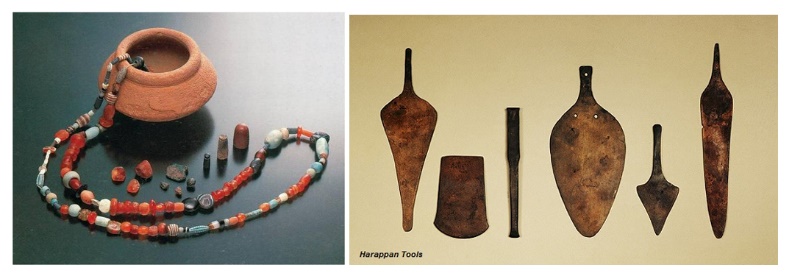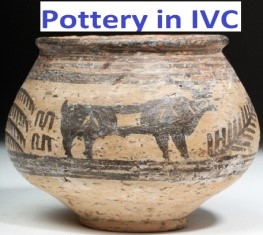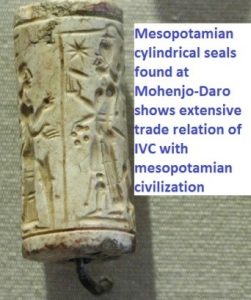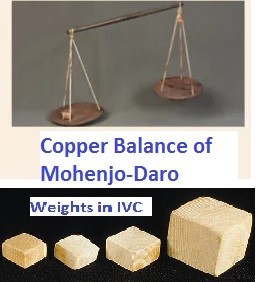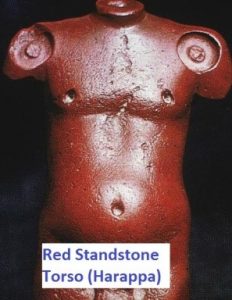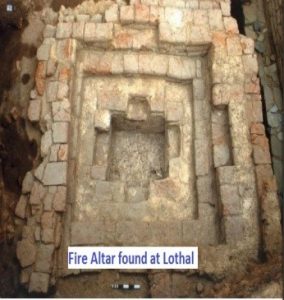Introduction of Harappan / Indus Valley Civilization
Bronze Age Civilization - Indus Valley Civilization (IVC)
Overview:
- The Indus Valley Civilization (IVC) or Harappan Civilization was the first urban civilization in South Asia.
- IVC, along with Mesopotamian, Egyptian, and Chinese civilizations, were the earliest of settlements showing complex societal life and were called “Cradles of Civilization”
- IVC is part of Proto-history and has been divided into three phases
Importance:
- Important topic for both UPSC Prelims and Mains perspectives
Details:
- IVC is also known as the Harappan Civilization
- It is the first urban civilization in South Asia
- IVC is part of Proto-history, which is the period before written records
- Along with Mesopotamian, Egyptian, and Chinese civilizations, IVC was one of the earliest settlements showing complex societal life and are known as “Cradles of Civilization”
- IVC has been divided into three phases for study purposes

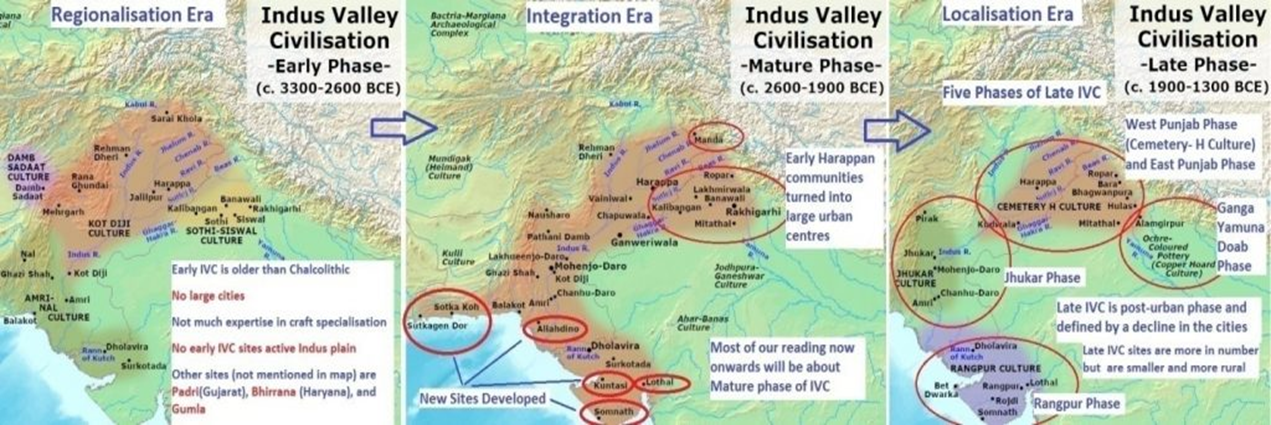
Theory of Origin of IVC
Origin of Harappan culture is not entirely agreed upon, but it is generally believed to have emerged from the Pre-Harappan indigenous village culture.
Recent DNA analysis of skeletal remains discovered at the Rakhigarhi cemetery challenges the previous theory that Harappans were descendants of Steppe pastoral or Iranian farmer ancestry. The study suggests that the people of IVC had an independent origin.
Town Planning
| Features | Description | Significance |
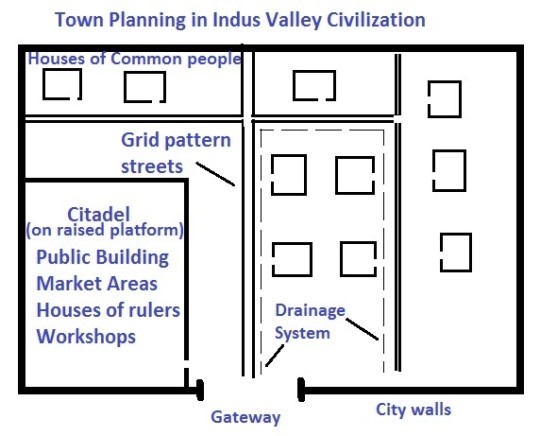 |
Division of City
Raised Part (called Citadel): Consisted of housing for rulers and important public buildings such as granaries, workshops. It was mostly situated west of the city.
Lower Part (eastern side of town): Consisted of houses of common citizens (see illustration map) |
It shows the presence of social hierarchy and some administrative authority.
Also, the Public and Private sphere was separated as the town was divided into two parts (as is also done in modern town planning) |
| Streets | It followed a grid pattern (i.e. streets cut each other at right angles, thus dividing the city into several rectangular blocks) |
It shows excellent knowledge of measurement and urban planning of Harappan people. |
| Drainage system | Drains connected all the houses and were made up of mortar, lime, and gypsum and covered with large brick slabs for easy cleaning |
It shows Harappan people paid great attention to Health and Sanitation |
| Houses | They were often of two or more stories, but no window faced the streets |
Often the 2nd story was made on 1st when it had subsided. It shows Harappan inhabited the place for a longer time |
| Building materials | Standardized burnt-bricks of ratio 1:2:4 found in all the sites (no stone was used) (*Egyptian civilization at that time used mud-bricks and stones) | It shows the presence of centralized weights and measurement systems. |
| Features | Description | Significance |
| Division in Society | Harappan society was an urban society and comprised of at least three distinct social groups: Ruled, rich merchants, and poor laborers who lived in the lower part of the city | It shows the division of labor and specialization in Harappan society. It also shows that Harappans had well organized administrative machinery |
| Clothing | Harappan people generally wore garments of cotton and wool | It shows advancement in the weaving of cotton and wool and diversification of choices |
| Food Habits |
The Harappan societies of Sindh and Punjab largely consumed wheat and barley while those of Rangpur and Surkotda consumed rice and millets. Fish and Molluscs eating was also common Dairy production evidence has been found by the recent molecular study at the Kotada Bhadli (Gujarat) |
The urban settlement near river valleys provided fertile ground for a variety of crops to be grown. Harappans were advanced in their agriculture practices. |
| Religion |
Harappan believed in Nature Worship– Gods in the form of trees such as Peepal and animals (bull). Idolatry was prevalent, they also worshipped Mother goddess, Pasupati yogi (lord of cattle), and Phallic symbols |
Harappans were called secular society as no temple (except for the great bath) or religion have been found (unlike in other contemporary civilizations) |
|
Script and Languages
|
Harappan script disappeared by 1700 BCE, showing the lack of percolation of the writing of IVC to other civilizations |
Recent theories have pointed out the similarity between ancient Tamil and Harappan scripts. But until the Harappan script is deciphered, the conclusion cannot be made
|
| Beliefs | Harappans believed in evil forces and ghosts and used amulets as protection against them | This was true about most of the primitive society |
|
Burial practices
|
Dead bodies were placed in the North-South direction (extended inhumation) and were accompanied by food, pottery, jewelry, etc. The graveyard was within the settlement. They practiced three types of burial:-
|
It shows their strong belief in life after death, which was similar to the belief system of other contemporary civilizations, however; the items kept were not as expensive as other civilizations. |
vi. Society
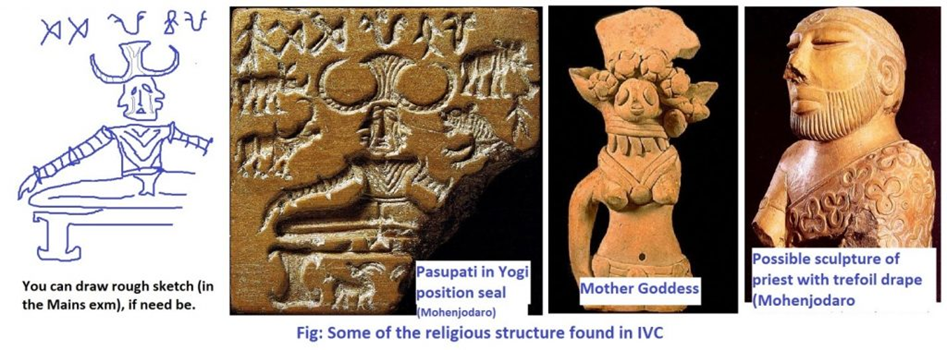
v. Economy
|
Features |
Description |
Significance |
| Agricultural economy |
Main crops were Wheat, Barley, Rice (found in Lothal and Rangpur only), Dates, Mustard, Cotton (1st in the world) |
It shows the advancement of Harappans in agriculture technology – used wooden plowshare, Well irrigation (Alladinho), Dams, and irrigation canals (Dholavira) |
|
Manufacturing |
Terracotta: figurines of animals, humans (more female figurines than male figurines), Bangles, seals Art of Bead-making (Chanhudaro and Lothal), jewelry- gold and silver jewelry at Allahdino a lot of necklaces made of gold, silver, and semi-precious stones have been found Harappans did not use Iron but used Copper, bronze, silver, and gold The number of pure copper artifacts was found in far greater number than alloyed bronze ones Harappans were the first to use silver in the world |
|
|
Pottery
|
The Harappans used Red and Black pottery (Redware painted with black designs) and also knew the use of Potter’s wheel with ease |
It shows the expertise of Harappans in pottery making e.g. Glazed pottery (Harappa), incised pottery, perforated pottery, etc. |
|
Trade
|
Harappans had trade with Mesopotamia (Sumeria), Central Asia, Persia, Afghanistan Makan (Oman), and Dilmun (Bahrain). Trade was through the barter system. Export items: Teak ( obtained from Gujrat), Amazonite (Hirapuri, GJ), Slate (Kangra), Lead (Kashmir and South India), Copper (from Baluchistan and RJ(Khetri mines)) Import Items: Jade (from Central Asia); Turquoise (from Khorasan); Lapis Lazuli, Gold, Silver, Tin ( from Afghanistan) (Gold was also obtained from Iran and Kolar mines in Karnataka); Steatite (Iran) |
It shows the advanced trade relation of Harappan civilization with other parts of India as well as also with other contemporary civilizations.
|
|
Weights and Measures
|
Weights followed a binary system — 1, 2, 8, 16, 32 to 64, 160, 320, 640, 1600, 3200, and so on. Weights were made of chert, limestone, and steatite and were generally cubical The measure of length was based upon a foot of 37.6cm and a cubit |
The standardization and accuracy of weights and measures throughout the IVC were remarkable. |
|
Seals
|
|
Harappan seals are the greatest artistic creation and were used to mark ownership of property and in trade |
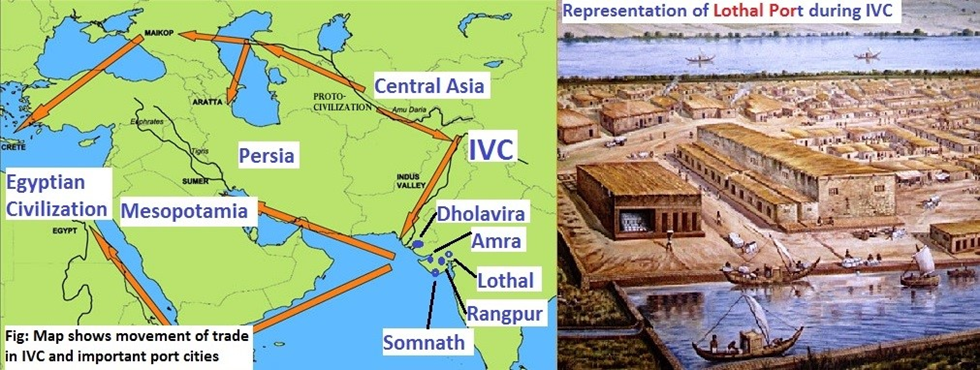
Theory of Decline of IVC
IVC declined after 1900 BCE, however, reasons for the decline are still disputed. There are various theories for its decline such as – (* No need to remember all these names, just glance at it)
| Causes | Historians |
| Drying of Ghaggar river and increasing aridity | D.P Agrawal and Sood |
| Flood | Macay and S R Rao |
| Low Rainfall | Dales, Vatsa and Lambricks |
| Ecological Disturbance | Fairchild |
| Aryan Invasion | Wheeler and Gordon |
| Earthquake | Raikes and Dales |
| Natural Calamity | K.A.R Kennedy |
A recent finding titled ‘Neoglacial climate anomalies and the Harappan metamorphosis’, done by an international team of scientists has suggested climate change as the possible reason for the decline of the Indus Valley Civilisation. Changes in temperature and precipitation led to the decline of monsoon and drying up of the Ghaggar-Hakra River. This led to a decline in crop and urban Harappan society turning rural.
Special features of some Important Harappan Sites
| Sites | Features |
|
Harappa (on Ravi River)
|
|
|
Mohenjo-Daro (Indus river) (mounds of Dead)
|
Bronze mirror, needle, saw, and the Bronze statue of the bull 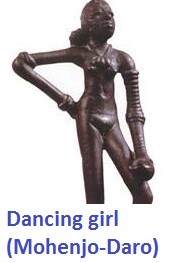 |
|
Lothal (Bhogava River, Gujarat) (also means ‘mounds of dead’ like Mohenjo-Daro) 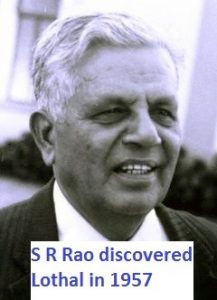 |
relation with Nile valley civilization)
Panchtantra Sacrificial Altar (at Lothal and Kalibagan)- Shows medical and surgical skills
|
|
Dholavira (Khadir bet island in the Kutch Desert Wildlife 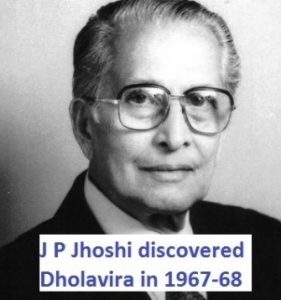 |
It was a walled city with heavy fortification
the decline of Mesopotamian civilization, showing the integration of the Trade economy)
(India’s 40th) 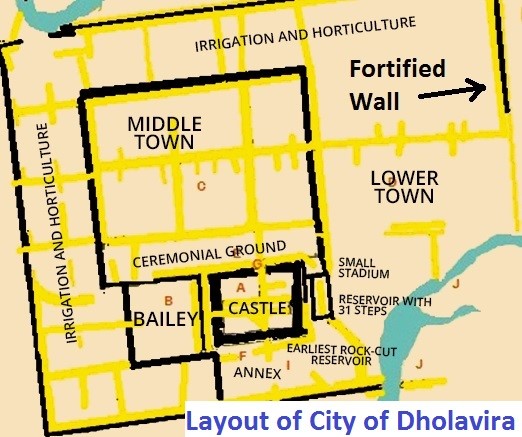 |
|
Rakhigarhi (on Ghaggar –Hakra river, Haryana) 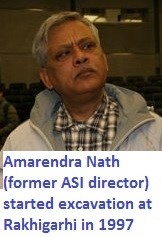 |
people lived)
IVC ( earlier it was known to have all three phases of IVC)
the Saraswati in 2000 BC Government (2021-22 budget) will fund on-site museums (also at Hastinapur (UP), Shivsagar (Assam), Dholavira (Gujarat), and Adichanallur (TN) |
| Chanhudaro (on Indus river) |
|
| Kalibangan (on Ghaggar river, RJ) (means ‘Black Bangles’) |
Fire altars (shows cult of sacrifice) |
| Bhirrana (Haryana) |
Now considered to be Oldest discovered IVC site dating back to 7500 BCE (earlier Mehargarh (Pak) was considered to be Oldest ) |
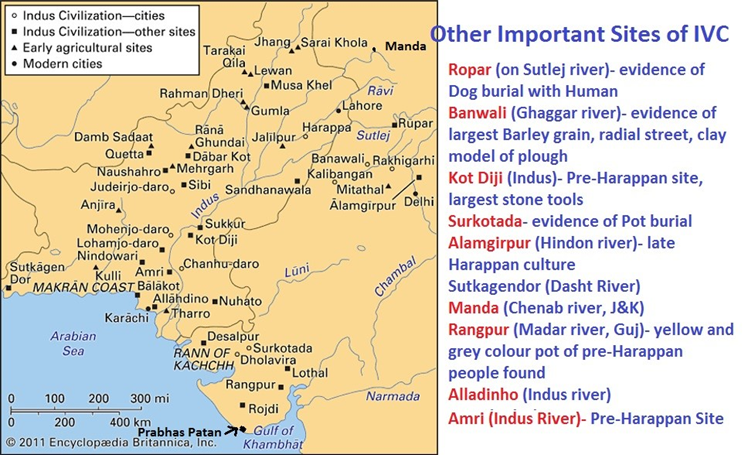
Differences between IVC and that of Egyptian and Mesopotamian Civilization:
|
Features |
HARAPPAN |
EGYPTIAN/MESOPOTAMIAN |
| Urban Planning | Planned towns with a grid-like pattern | Towns show haphazard growth |
| Script | Invented their own typical pictographic script |
Mesopotamia has a cuneiform script and the Egyptian script is known as hieroglyphics. Both scripts have been deciphered |
| Writing Material | The majority of the Script has been found on the seals |
The majority of the Mesopotamian script has been found on the clay tablets while Egyptians wrote on papyrus sheets made of reeds. |
| Extent of Civilization | Spread was 20 times that of Mesopotamian and Egyptian Civilization | Less area as compared to IVC |
| Building Material | Burnt Bricks | Egyptians used Dried Bricks, whereas Mesopotamians used Baked Bricks |
| Religion | No temples or religious structures have been found | Had elaborate religious practices, magic spells, and dominance of priest |
| Weapons | No clear evidence of war or weapons | Clear evidence of wars and expedition in other two civilizations |
| Decline of Civilization | Declined after 1900 BCE | Both the civilization continued to exist even after 1900 BCE. |
Similarities in IVC and Egyptian / Mesopotamian Civilization:
- Along river valleys: IVC was along Indus river basin, Sumerian developed between Tigris and Euphrates river basin while Egyptian civilization developed along Nile river basin.
- Agricultural society: They all developed as an agrarian society with a large agricultural class that was responsible for growing food for large centralized urban populations of the city.
- Egalitarian society: Women were relatively empowered in these civilizations with IVC showing evidence of mother goddess worship.
- IVC had a large number of shrines of female deities showing women had a certain degree of independence.
- Women in Mesopotamia and Egypt could make their own business and trade contracts and own property and could even become a ruler (e.g. female pharaoh Hatshepsut)
- Developed trade, manufacturing, and Commerce: Being free from the burden of growing food, these civilizations had a large merchant and artisans’ base
- Highly urbanized: They had sophisticated transport and economic networks. This enabled them to spread to larger areas and support advanced crafts, artistic production, sophisticated religions, technology, and government bureaucracies.
- Nature worship: Although not much is known about IVC religion, however, other two civilizations had polytheistic religions, consisting of nature worship.
- Writing and Script: All of them had well-established art of writing and script
- Burial practices: All three civilizations buried their dead with items needed in the afterlife
Facets of IVC yet to be Ascertained
Harappan Script
- The Harappan script has not been deciphered yet due to several reasons
- The script shows less than 30 characters, unlike other ancient civilizations with a true writing system that have long writings (more than 100 characters)
- No multi-lingual script like the Rosetta Stone inscription has been found for Harappan script
Origin and Extent of IVC
- Little is known about the origin of the people of the Indus Valley Civilization
- It is unclear where they came from, what language they spoke, what kind of social organization or rulers they had, or what their names were
- New excavations show that Rakhigarhi was a bigger city than Mohenjo-Daro or Harappa, two previously considered centers of the Indus civilization
Decline of IVC
The IVC declined around 1800 BCE, but the reasons for its demise are still debated
Linkage of IVC to Southern Civilization
- Recent excavations and studies of the Indus Valley script and the Tamil-Brahmi script suggest that there may have been an urban, Bronze age civilization in India’s southern region
- After the collapse of the Indus civilization, the remaining members of the civilization may have migrated south
- However, these findings are still disputed.

